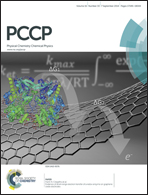Drastic change of the intrusion–extrusion behavior of electrolyte solutions in pure silica *BEA-type zeolite
Abstract
High pressure water and electrolyte solutions intrusion–extrusion experiments in pure-silica *BEA-type zeolite (zeosil β) were performed in order to study the performances of these systems in energy absorption and storage. The “zeosil β–water” system displays a bumper behavior with an intrusion pressure of 53 MPa and an absorbed energy of 8.3 J g−1. For the “zeosil β–LiCl aqueous solutions” systems the intrusion pressure increases with the LiCl concentration to 95, 111 and 115 MPa for 10, 15 and 20 M solution, respectively. However, for concentrations above 10 M, a transformation of the system behavior from bumper to shock-absorber is observed. The zeolite samples were characterized by several structural and physicochemical methods (XRD, TGA, solid-state NMR, N2 physisorption, ICP-OES) before and after intrusion–extrusion experiments in order to understand the influence of the LiCl concentration on the intrusion–extrusion behavior. It is shown that the intrusion of water and LiCl solutions with low concentration leads to the formation of Si-(OSi)3OH groups, whereas no defects are observed under intrusion of concentrated LiCl solutions. A possible mechanism of LiCl solution intrusion based on separate intrusion of H2O molecules and Li(H2O)x+ ions is proposed.


 Please wait while we load your content...
Please wait while we load your content...